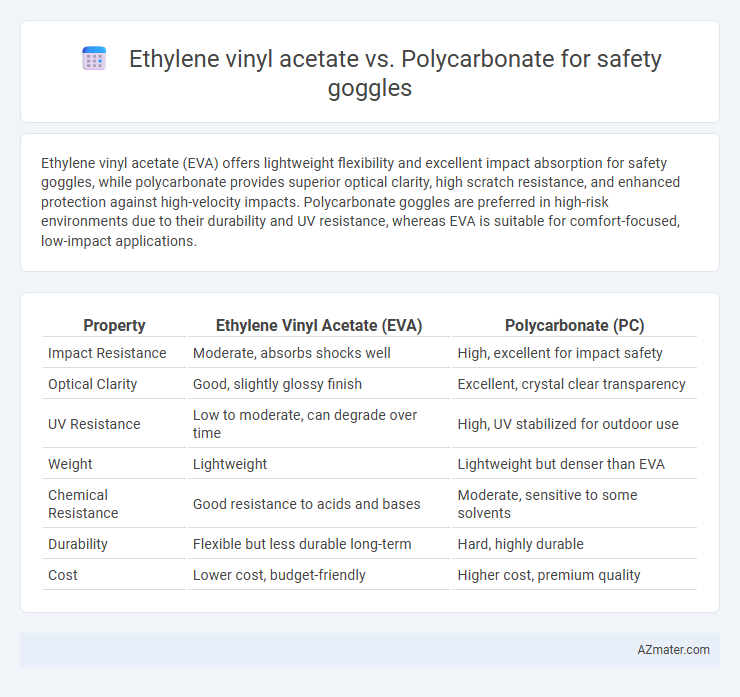Ethylene vinyl acetate (EVA) offers lightweight flexibility and excellent impact absorption for safety goggles, while polycarbonate provides superior optical clarity, high scratch resistance, and enhanced protection against high-velocity impacts. Polycarbonate goggles are preferred in high-risk environments due to their durability and UV resistance, whereas EVA is suitable for comfort-focused, low-impact applications.
Table of Comparison
| Property | Ethylene Vinyl Acetate (EVA) | Polycarbonate (PC) |
|---|---|---|
| Impact Resistance | Moderate, absorbs shocks well | High, excellent for impact safety |
| Optical Clarity | Good, slightly glossy finish | Excellent, crystal clear transparency |
| UV Resistance | Low to moderate, can degrade over time | High, UV stabilized for outdoor use |
| Weight | Lightweight | Lightweight but denser than EVA |
| Chemical Resistance | Good resistance to acids and bases | Moderate, sensitive to some solvents |
| Durability | Flexible but less durable long-term | Hard, highly durable |
| Cost | Lower cost, budget-friendly | Higher cost, premium quality |
Introduction to Safety Goggles: Importance of Material Choice
Safety goggles demand materials that provide impact resistance, optical clarity, and chemical durability. Ethylene vinyl acetate (EVA) offers flexibility and chemical resistance but has lower impact strength compared to polycarbonate, which is renowned for its exceptional impact resistance and optical clarity. Choosing polycarbonate enhances user protection in hazardous environments, making it the preferred material for high-performance safety goggles.
Overview of Ethylene Vinyl Acetate (EVA)
Ethylene Vinyl Acetate (EVA) is a copolymer characterized by its excellent flexibility, impact resistance, and clarity, making it an ideal material for safety goggles that demand comfort and durability. EVA offers superior cushioning and shock absorption compared to rigid materials like polycarbonate, enhancing wearer protection through energy dispersion. Its lightweight and chemical-resistant properties also contribute to long-lasting safety equipment that maintains optical clarity under various working conditions.
Overview of Polycarbonate (PC)
Polycarbonate (PC) is a durable, impact-resistant thermoplastic widely used in safety goggles, providing superior protection against high-velocity impacts and shattering hazards. Its exceptional optical clarity and UV resistance make it ideal for extended wear in various industrial and laboratory environments. Compared to Ethylene Vinyl Acetate (EVA), polycarbonate offers greater strength, heat resistance, and dimensional stability, ensuring reliable eye protection under extreme conditions.
Impact Resistance: EVA vs Polycarbonate
Polycarbonate offers superior impact resistance compared to Ethylene vinyl acetate (EVA), making it the preferred material for safety goggles in high-risk environments. EVA provides moderate impact absorption but lacks the hardness and shatterproof properties of polycarbonate, which can withstand impacts from high-velocity objects without cracking. Polycarbonate's impact resistance rating typically exceeds 99% protection against UV rays and debris, ensuring enhanced safety for eye protection applications.
Optical Clarity and Visual Performance
Ethylene vinyl acetate (EVA) offers moderate optical clarity with good flexibility, making it suitable for comfortable safety goggles but may exhibit slight haziness under certain lighting conditions. Polycarbonate provides superior optical clarity and excellent visual performance due to its high light transmittance and impact resistance, ensuring minimal distortion and enhanced visibility. For applications demanding precise vision and maximum protection, polycarbonate is the preferred material over EVA in safety goggle lenses.
Comfort and Wearability: Material Differences
Ethylene vinyl acetate (EVA) offers superior flexibility and lightweight properties, enhancing comfort and reducing pressure during extended wear of safety goggles. Polycarbonate, while more impact-resistant and durable, tends to be stiffer and heavier, which can decrease comfort over prolonged periods. The softer, more pliable nature of EVA improves wearability by conforming better to facial contours, minimizing discomfort and ensuring a secure fit.
Chemical and UV Resistance Comparison
Ethylene vinyl acetate (EVA) offers excellent chemical resistance, particularly against acids, bases, and oils, making it suitable for environments with exposure to harsh substances. Polycarbonate, while less resistant to organic solvents and certain chemicals, provides superior UV resistance, effectively blocking harmful ultraviolet rays and preventing lens degradation. For safety goggles, choosing polycarbonate ensures enhanced UV protection, whereas EVA excels in chemical durability for environments with aggressive chemical exposure.
Durability and Longevity
Ethylene vinyl acetate (EVA) offers excellent flexibility and impact resistance, making it suitable for safety goggles that require lightweight durability but may degrade under prolonged UV exposure. Polycarbonate goggles provide superior durability with high impact resistance and UV protection, ensuring long-term clarity and strength for extended use in harsh environments. The choice between EVA and polycarbonate depends on the balance between flexibility and robust, long-lasting protection in safety applications.
Cost Effectiveness and Availability
Ethylene vinyl acetate (EVA) offers a cost-effective option for safety goggles due to its lower material and manufacturing expenses compared to polycarbonate, making it widely accessible in budget-conscious markets. Polycarbonate, while more expensive, provides superior impact resistance and optical clarity, which justifies its higher price in environments requiring enhanced protection. Availability of EVA is generally higher in mass-produced, economical safety goggles, whereas polycarbonate is prevalent in premium models favored by industries prioritizing durability and safety compliance.
Best Use Cases: Choosing the Right Material for Safety Goggles
Ethylene vinyl acetate (EVA) excels in lightweight, flexible safety goggles ideal for impact resistance and comfort during extended wear in environments like laboratories and construction sites. Polycarbonate offers superior durability, high impact resistance, and UV protection, making it the best choice for high-risk industrial applications such as manufacturing and welding. Selecting EVA or polycarbonate depends on balancing factors like impact resistance, weight, and specific safety requirements to ensure optimal eye protection.

Infographic: Ethylene vinyl acetate vs Polycarbonate for Safety goggle
 azmater.com
azmater.com